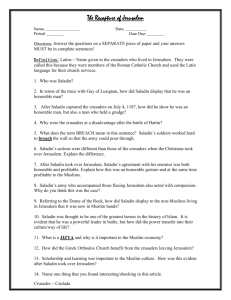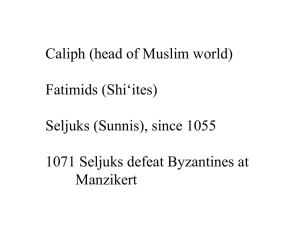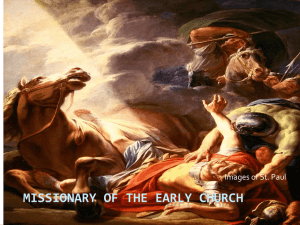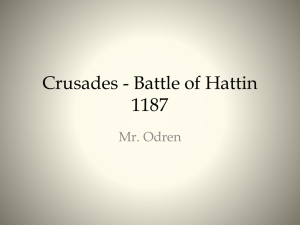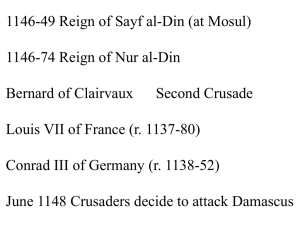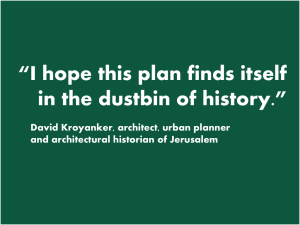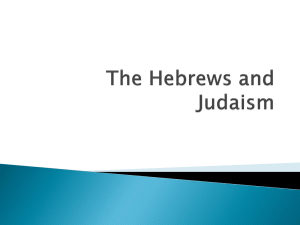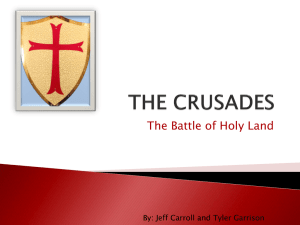The Crusader States - IB DP History Medieval Option
advertisement
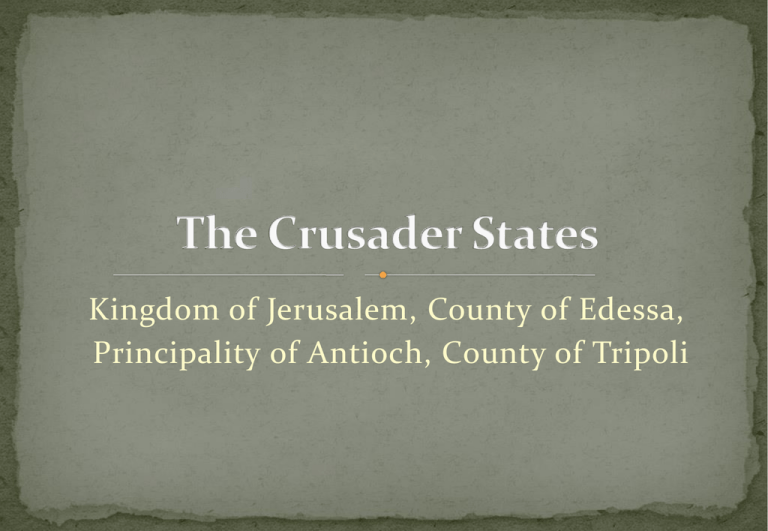
Kingdom of Jerusalem, County of Edessa, Principality of Antioch, County of Tripoli The Latin States (Crusader States) were developed on feudal principles by their rulers, feudalism tailored to meet the different circumstances of the near East. Baldwin of Flanders/Baldwin of Boulogne founded the county of Edessa on the way to Jerusalem in 1098 Bohemond of Taranto set up the principality of Antioch (not completing the pilgrimage to Jerusalem) Godfrey of Bouillon (descended from Charlemagne) became first ruler of the Kingdom of Jerusalem as ‘Advocate of the Holy Sepulchre’ Raymond of Toulouse established the county of Tripoli after the capture of Jerusalem The most vulnerable kingdom and had the shortest life. An Armenian kingdom, usurped by Baldwin of Boulogne Ruled by Baldwin of Boulogne (1098-1100). Ruled by Baldwin of Le Bourg (1100-1108) Both Baldwins later became kings of Jerusalem Ruled by Jocelin of Courtenay (1118-31) Ruled by Jocelin II (1131-1144) when the city fell to Zengi and marked the end of the County of Edessa Settled by Normans (southern Italian Normans) Under princes of the house of Hauteville, surviving with diminished territory until captured by Baibars (Baybars) from Bohemond VI in 1268. County of Tripoli Settled by those from Provence Only Frankish state based on a maritime city, ruled by the decendants of Raymond of Toulouse until 1187, when taken over by Hauteville family (Antioch). Lost in 1289 Settled by men from Lorraine and from northern France/Flanders Lasted until Saladin took the city in 1187. Thereafter the capital was centred on the coastal city of Acre. Rulers: Baldwin I of Boulogne (1100-1118), Baldwin II of Le Bourg (1118-1131), Count Fulk of Anjou (1131-43) with Queen Melisende, Baldwin III (1143-63), Amalric I (1163-74). Baldwin IV (1174-85), Baldwin V (1185-6), Guy of Lusignan (1186-92), Conrad of Montferrat (1192), Henry of Champagne (1192-7), Amalric II (1197-1205)…. 1. Chronic shortage of western military manpower (most crusaders returned home including, for ex. Robert of Normandy and Robert of Flanders. In Jerusalem Godfrey had just 300 knights and 2000 footsoldiers to call on for support. In all, there were never more than 2000 knights available in the entire Latin controlled territories for defence. 2) The Franks/crusaders were always in the minority within the four Latin States – estimated population of Frankish settlers – 250,000 – half in the Kingdom of Jerusalem. Acre approx. 60,000, Tyre and Jerusalem 20,00030,000. This meant they had to come to terms with both the mixture of predominantly Eastern, Jewish and Muslim people who made up most of their subjects. The need to make agreements with local Muslim rulers led to disagreements and misunderstandings among the first western settlers and with later contingents of crusades who came from Western Europe to support the states in the early years of the 12th century. Later crusaders regarded all Muslims as enemies, and made no distinction between those Muslim rulers who were friendly or hostile towards the established crusader states. This was an important contributory cause of the failure of the Second Crusade in the 1140s. 3) The crusading states generally, and Jerusalem in particular, lacked natural geograhphical boundaries which, combined with their shortage of manpower, created major problems of defence. Two key strategic needs were to extend the crusader’s control from the confines of the coastal plains to the desert frontier cities of Aleppo and Damascus, but the crusaders never successfully achieved this. The Kingdom of Jerusalem required control of its southern boundary with Egypt if it was to gain permanent stability. The crusaders failed to achieve this. Attempts at settlement To solve the problem of manpower a number of measures were taken: Settlers from the West were offered lands to settle. Towns such as Caesarea were deliberately developed as crusading settlements. This solved the problem of manpower in two ways: (i) It constituted a kind of colonising settlement for further crusaders from the West to settle (ii) It was a gateway (like the other coastal towns) through which further settlers and crusaders from the West could reach the states. There were never quite enough settlers for the needs of the crusader states, and the inhospitably hot climate seems to have been particularly severe on male new-born children. This meant that the manpower shortage was not solved. Crusader Castles and the Monastic Orders Two orders of monks were founded, unique to the Latin States. These were military orders of knights dedicated to the protection of Christians in the Holy Land, and the preservation of the Latin States in the East. The Military Orders represent the fundamental crusading ideal of knighthood fighting as religious warriors against the enemies of Christ. Members of the Orders were few but often remarkable men. The Orders were entrusted with substantial areas of territory to defend, usually in regions bordering Muslim states, for example in northern Tripoli Though their numbers never exceeded a few hundred, the Military Orders were important elements in the military resources available to the Kingdom of Jerusalem and its neighbouring Latin States. Many grants of land and wealth were made to the Templars and Hospitallers by the inhabitants of the Latin States, and the heads or Masters of the two Orders became important figures in the politics of the Kingdom of Jerusalem. Belvoir, near the Sea of Galilee was the first genuinely concentric castle (1168). Only a few knights were needed to man Belvoir due to the superbly planned defensive principles behind its structure. The most famous castle of the Hospitallers was Krak des Chevaliers. It was the greatest and most ambitious of the Military Order’s fortifications, with walls 10 meters thick in places. The fortifications were vastly expensive. They partially compensated for the Crusader States’ lack of manpower, but proved insufficient to enable the States’ rulers to extend their authority from the central plain in the West to the desert strongholds of Aleppo and Damascus. They were substantial contributions to the defences of the Crusading States, but not very effective in enabling them to realise their basic need of establishing readily defended natural boundaries by extending their territorial controls. After almost a century during which they preserved a precarious existence, the Crusading States began to be retaken by the Muslims. They were defeated by their basic manpower problem and the lack of sucess, partly due to this, in gaining easily defended natural frontiers. In the mid-12th century, the Muslim world, which had been divided at the time of the First Crusade, became reunited under a series of great leaders. Rise of Muslim opposition Zengi, Nur ad-Din, Salah ad-Din (Saladin). ZENGI 1128, Zengi, the govenor of Mosul entered the city of Aleppo and embarked on a series of conquests of Muslims and Christians. 1135 Zengi cleared the south-western approaches of Aleppo of Christian forces 1137 he took Ba’rin from the county of Tripoli November 1144 attacked the County of Edessa Christmas Eve 1144 Edessa fell to Zengi and this sparked the Second Crusade He had taken advantage of the idea of jihad, holy war, against the Franj. Zengi died in 1146 at the hands of one of his slaves, whilst he slept. He was succeeded by his younger son, Nur ad-Din June 1149 Nur ad-Din defeated an Antiochene (from Antioch) army, a victory which heralded him as the champion of Islam. The concept of jihad during the crusades had two aspects…. Two aspects of jihad during the crusades: Reconquest of the coastal lands, especially Jerusalem from the Christians 2) Achievement of Muslim religious and political unity 1) Over the next 20 years, Nur ad-Din consolidated his hold on the Muslim world. April 1154 took Damascus June 1155 took Ba’albek, unifying Syria 1170 took Mosul By his death in 1174, Nur ad-Din had transformed the Muslim political scene: «In place of a confused jumble of petty states there was now a powerful and united Syria, with Egypt under its suzerainty» (Jonathan Riley-Smith) In spite of this new-found unity, there was a power struggle after his death, in which Saladin, the Vizier of Egypt was successful by 1175. Saladin took over the smaller Muslim states in a series of great victories from his power base in Egypt. 1174 Damascus fell to him 1183 Aleppo fell to him Saladin’s territories encircled the Crusader States He launched a series of attacks on the Kingdom of Jerusalem (1170, 1171, 1173, 1177, 1179, 1180, 1182, 1183, 1184), though with no real concrete progress to show for these efforts. Jerusalem remained a Christian state. On 2nd July 1187, Saladin attacked the Kingdom of Jerusalem at the frontier town of Tiberias. The Christians were, at this stage exceptionally weak and divided following the ddeath of the leper king Baldwin IV. Saladin’s army of 30,000 included 12,000 cavalry, and King Guy of Jerusalem could only muster 20,000 men of who 1,200 were knights, to oppose Saladin’s forces. On 4th July 1187, at the Battle of Hattin, Saladin virtually annihilated the crusading army. King Guy and the fragment of the True Cross (a holy Christian relic) were captured by the victorious Muslims. On 2nd October 1187, Jerusalem was occupied by Saladin’s forces. The city’s fall shocked the western world. Within two years, Saladin had captured over 50 crusader castles and little more than the port of Tyre remained in Christian hands. The capture of Jerusalem sparked the Third Crusade in an attempt to retake Jerusalem from Saladin’s control. 1100-1130 – Period characterised by Latin expansion and advances 1130-1153 – Christians on the defensive 1153-1169 – Campaigns against Egypt 1169-1187 – Latin States back on defensive Invasion from Egypt (1101, 1102, 1103, 1105, 1106, 1107, 1110, 1115, 1118, 1123) Capture of key towns (Arsuf and Caesarea 1101, Acre 1104, Beirut and Sidon 1110, Tyre 1124, Ascalon 1154) Drive into the interior of Palestine – eastwards towards Damascus (1122, 1129) and Aleppo (1100, 1125) Invasion of Egypt by Baldwin I (died 1118) Inability to recover what they lost, though capable of some sporadic attacks. Lost Edessa, Ba’rin Only two major offensives (Seijar in 1137 with Greek/Byzantine help & Damascus in 1148 with the Second Crusade) Occupation of Ascalon in 1154 Invasions of Egypt by King Amalric (1163, 1164, 1167, 1168, 1169) all strained the kingdom’s resources Saladin regularly invaded the Kingdom of Jerusalem, taking it on 2nd October 1187 The First Crusade and the Crusader States 1073-1192 Chapter 5, pages 54-68 Chapter 6, pages 69-79 Chapter 7, pages 80-83 Chapter 8, pages 93-103 Chapter 9, pages 104-116 Course Booklet: The Crusades 1095-1291 Section 3 – Foundation of the Crusader States Section 6 – Military Asepcts of the Crusades and Crusader States
